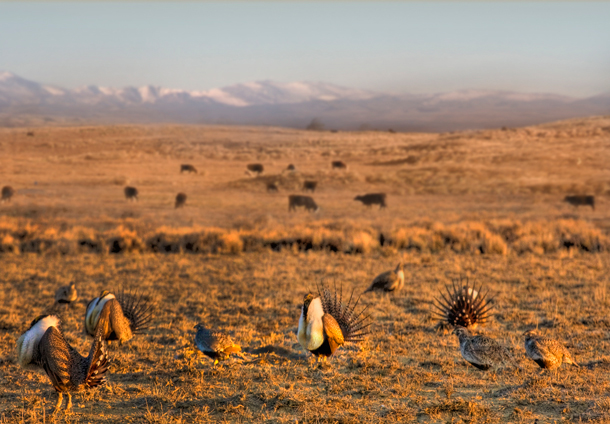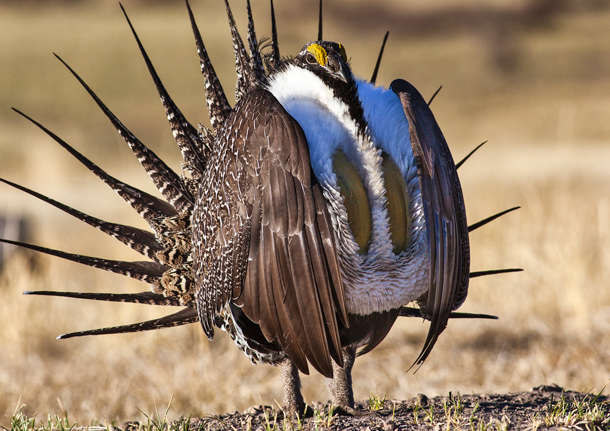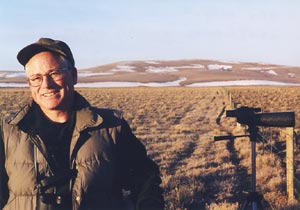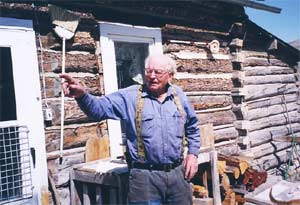The Sage Hen and the Sage Brush
Air Date: Week of April 12, 2019

The sage brush steppe ecosystem is vital for sage grouse leks, where the birds mate. (Photo: Susan Loredo, U.S. Department of Agriculture, Flickr, CC BY 2.0)
We revisit an earlier Living on Earth report about the threats to the Greater Sage Grouse from oil drilling, grazing, and invasive plant species. Living on Earth’s Clay Scott reports on the debate between conservationists and private landowners about how best to protect this dwindling species and the sagebrush ecosystem on which it depends.
Transcript
CURWOOD: It’s Living on Earth, I’m Steve Curwood.
Earth Day is April 22 and in honor of Earth month we are looking back at some of our favorite stories and bringing you an update. This week it’s Clay Scott’s 2002 story about the Greater Sage Grouse. For decades this showy bird has been ruffling feathers among western cattle ranchers and energy developers working in sage brush country. This landscape at first almost seems completely barren, but it’s crucial habitat for a wide variety of wildlife. Greater Sage Grouse are extremely sensitive to disturbances in their habitat and their numbers have plummeted from millions in the 1800’s to less than 200,000 today. Although the Greater Sage Grouse is not listed as endangered, a sub species identified in the year 2000 and now called the Gunnison Sage Grouse is on the endangered species list in the ‘threatened ‘category. Here is Clay Scott’s 2002 report.
SCOTT: On a cold spring morning in southwest Montana, Ben Deeble of the National Wildlife Federation is out looking for Sage Grouse. The sun is just coming up, but at 6,000 feet elevation the temperature is below freezing. Deeble walks briskly through the sagebrush. There are no obvious landmarks in this vast sea of grayish-green, but he knows exactly where he’s going. He stops and points.
DEEBLE: See where the light is hitting the high cut bank. Go to the right to the dark cut bank and there’s two cocks right below that.
SCOTT: Through my binoculars I make out two distant patches of white, the neck feathers of male sage grouse. This is their communal mating ground, called a "lek." For a two-week period in the spring the mottled brown and black males congregate at the lek before dawn. They strut, spread their fan-like tails, and rub their wings across inflated air sacs on their necks, hoping to attract females. I ask Deeble why the birds have chosen this place for their lek.
DEEBLE: This is a good spot because the sagebrush isn’t very tall, but they need to go to tall sagebrush with a lot of grass and Forbes for safe nesting. So probably the hens are nesting a mile or more from here.
[OUTSIDE AMBIENCE]
SCOTT: The wary birds flush before we get close enough to observe their mating display. They’re as big as large chickens, but surprisingly fast flyers. Deeble takes out a GPS unit, notes our position and records the number of grouse we saw. Next spring researchers will be able to return to this same spot to count the number of mating birds. Sage Grouse can have home ranges of hundreds of square miles, yet each year, like spawning steelheads, they return to the exact same spot to mate. But that extraordinary fidelity to place also makes them vulnerable to changes in their habitat, and almost everywhere the birds live that habitat is being altered, sometimes radically.
DEEBLE: What we find is everywhere in these habitats we’re disturbing them in ever-increasing tempos. For whatever reason, they’re like the canary in the coal mine, from the standpoint that they’re one of the first species that disappears as these sage steppe ecosystems become unraveled.
SCOTT: The sage steppe ecosystem is a vast, arid area of mostly public land stretching from eastern California to the western edge of the Dakotas. Healthy sage steppe includes a variety of sagebrush species, along with bunchgrasses and other plants. But much of the ecosystem is in decline along with many of the species that live in it. Sage Grouse, in particular, are dependent on old growth sagebrush. Their mating and nesting grounds have been disturbed by oil and gas drilling, coal bed methane development, the conversion of sagebrush to agriculture, and especially by the grazing of livestock.
Historic over-grazing in the sage steppe has reduced native grasses that many species depend on and led to the spread of invasive weeds that thrive in degraded soil. One recent study estimates that exotic weeds in sage country are spreading at more than 4,000 acres per day. Throughout the west the majority of grazing has been on leased federal land. Now, some environmental groups say it’s time for that practice to stop for the sake of the sage grouse and for the health of the entire ecosystem. But ranchers here say banning grazing on public land would deal a death blow to entire communities. Roger Peters is the owner of the Dragging Y Ranch. Like many ranchers, he’s suspicious of what he calls the environmental agenda.

Male greater Sage Grouse perform a dance in which they fill their two bulbous air sacs and flop their head in order to attract a mate. Female sage grouse pick from among them, and often return to the same male every year. (Photo: Bob Wick, Bureau of Land Management, Flickr, CC BY 2.0)
PETERS: In Beaverhead County, Montana, we’re dependent on grazing on federal lands because that’s so much of what there is. You know, we live here. You have to use federal lands because there’s not enough deeded land to go around. So now it appears to us that Sage Grouse, they say, "Ah, Sage Grouse, we’ve got them on Sage Grouse. We’ll get them on something eventually to get their cows off the public lands."
SCOTT: Peters’ ranch is on 60,000 acres of his own land, along with several times that amount of leased federal land, much of it sage grouse habitat. He says he manages the land in an ecologically sound way and he has no patience for those who want to tell him when and where to graze his cattle. He’s especially angry at those environmental groups who think the sage grouse should be put on the endangered species list. If the bird is listed, Peters says, many western cattle operations would effectively be brought to a halt.
PETERS: Why penalize the guy that’s got the last one? He’s obviously the best caretaker of this endangered species, whatever it is. But whoever the poor guy is, the endangered species are found on his place, he’s the one whose management is penalized.
SCOTT: The advocacy group American Lands Alliance is leading the efforts to list the Sage Grouse. Mark Salvo works on sagebrush issues for the organization. He denies that his position is anti-rancher.

Ben Deeble of the National Wildlife Federation tracks the number of grouse in southwest Montana during the mating season. (Photo: Clay Scott)
SALVO: We’re not suggesting that public lands ought not be used. But we are suggesting that they have been used or abused in the past, and that changes need to be made. That’s what the plight of the Sage Grouse is showing us.
SCOTT: But not all environmental groups feel an endangered species listing is the answer, at least at this point. Groups like the National Wildlife Federation are working with state and federal agencies, as well as landowners and others, to develop management plans for Sage Grouse habitat. Ranchers are encouraged to keep their livestock away from nesting areas and to rotate their grazing to allow grass and other plants a chance to recover. Mark Salvo supports those efforts but says much more is needed. The looming threat of the Endangered Species Act, he says, is necessary to keep both ranchers and government agencies focused on the Sage Grouse issue.
SALVO: Unless that threat is there, unless we continue to push to list the species, they may back off on some of their current efforts to restore and conserve them. What my challenge is to resource users and agencies and others who don’t want to list the species on the Endangered Species Act is you probably have six to eight to ten years to reverse the declining trends for Sage Grouse and their habitat on your own.
SCOTT: Six to eight to ten years, because it will take at least that long for a final ruling on the status of the sage grouse. But some experts say that’s not nearly enough time, that much of the sage steppe is so degraded that decades will be needed to really turn things around. One federal biologist just sighed when I asked him how sage habitat might be restored. "The truth is," he said, "that we just don’t know. We can’t put it back the way it was because we don’t understand everything about how it used to be."
[SOUND OF STREAM]
SCOTT: Someone who does remember how things used to be is Bernard Harkness. In a high basin below the Continental Divide, where a snow-fed creek flows through low sagebrush, I found the retired sheep rancher standing in front of the rough log cabin he’s lived in for 77 years. He told me of a time when the birds and their habitat were in better shape.
HARKNESS: They would come in here right around the first of July, just thousands and thousands of them. I’ve seen them flying-- I don’t know how many you’d see, hundreds of thousands. It’s a big, open grassland, and wide; oh, five, six, seven miles. You can see in any direction that’s open there. As far as you could see, there would be sage grouse walking, eight to ten feet apart.
SCOTT: Harkness dug out a yellowed copy of The Lima Ledger from 1935 and pointed to an article titled "Hunters Bag Ton of Sage Hens." The headline was meant literally. In this basin alone, hunters killed 10,000 birds in a three-day season.

Bernard Harkness remembers when hundreds of thousands of sage grouse lingered in the grasslands near his cabin. (Photo: Clay Scott)
HARKNESS: If you wanted a Sage Grouse dinner then you’d just walk out with a .22; get three or four. You fried them, fried the breast. And then the others, the backs and the legs and the giblets, you’d make a gravy just like turkey gravy or something, and on the potatoes, and that was a pretty good meal.
SCOTT: As I was leaving, Bernard Harkness reminisced about the spring mating display of the sage grouse. "Before I die," he told me, "I’d sure like to see the birds do that dance again."
CURWOOD: That’s reporter Clay Scott in Montana back in 2002, and you can visit our website loe.org to hear more of that story. Clay did eventually get to see the birds do that dance. There weren’t thousands of them as Mr. Harkness remembered, just 5 males at a clearing calling and dancing for all they were worth to attract a female.
Links
National Wildlife Federation | “Saving the Greater Sage Grouse”
Living on Earth wants to hear from you!
Living on Earth
62 Calef Highway, Suite 212
Lee, NH 03861
Telephone: 617-287-4121
E-mail: comments@loe.org
Newsletter [Click here]
Donate to Living on Earth!
Living on Earth is an independent media program and relies entirely on contributions from listeners and institutions supporting public service. Please donate now to preserve an independent environmental voice.
NewsletterLiving on Earth offers a weekly delivery of the show's rundown to your mailbox. Sign up for our newsletter today!
 Sailors For The Sea: Be the change you want to sea.
Sailors For The Sea: Be the change you want to sea.
 The Grantham Foundation for the Protection of the Environment: Committed to protecting and improving the health of the global environment.
The Grantham Foundation for the Protection of the Environment: Committed to protecting and improving the health of the global environment.
 Contribute to Living on Earth and receive, as our gift to you, an archival print of one of Mark Seth Lender's extraordinary wildlife photographs. Follow the link to see Mark's current collection of photographs.
Contribute to Living on Earth and receive, as our gift to you, an archival print of one of Mark Seth Lender's extraordinary wildlife photographs. Follow the link to see Mark's current collection of photographs.
 Buy a signed copy of Mark Seth Lender's book Smeagull the Seagull & support Living on Earth
Buy a signed copy of Mark Seth Lender's book Smeagull the Seagull & support Living on Earth

